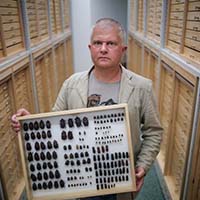Authors

Prof. dr hab. Jerzy Błoszyk
Adam Mickiewicz University
Faculty of Biology
Uniwersytetu Poznańskiego 6
61-614 Poznań, Poland
e-mail: jerzy[dot]bloszyk[at]amu[dot]edu[dot]pl
ORCID: 0000-0002-3615-2263

Dr inż. Marcin Lawenda
Poznań Supercomputing and Networking Center
Supercomputing Department
ul. Jana Pawła II 10
61-139 Poznań, Poland
e-mail: marcin[dot]lawenda[at]man[dot]poznan[dot]pl
ORCID: 0000-0003-4844-3655

Dr hab. Szymon Konwerski
Adam Mickiewicz University
Faculty of Biology
Chair of Natural History Collections
Uniwersytetu Poznańskiego 6
61-614 Poznań, Poland
e-mail: szymkonw[at]amu[dot]edu[dot]pl
ORCID: 0000-0002-6438-8759
Publications
Lawenda, M., Błoszyk, J., & Konwerski, S. (2023). Determination of the relativistic value of museum natural collections, Journal of Natural History, 57(37-40), 1671-1692, 10.1080/00222933.2023.2272350
About
In the case of a museum collection of paintings and works of art, it is valued. Single copies, e.g. paintings of famous painters, reach dizzying prices on the market. However, the same cannot be said of the existing nature collections. Because how to estimate the value of prepared and pinned insects, plants dried a hundred years ago, more or less skillfully stuffed animals, collected microscopic preparations or finally a collection of nature photos? At the same time, the matter becomes so urgent that immediate action must be taken. Although collecting various types of natural objects has a long tradition, it has never found such recognition in society as collecting archaeological artifacts, paintings, numismatics or philately.
Nature collections are very often exposed to destruction. Entomological collections, herbariums or stuffed animals stored in inappropriate conditions are easily damaged, either as a result of museum pests (insects, fungi) or as a result of mechanical damage. In this way, we often lose specimens that are priceless from a scientific point of view. And here we come to the heart of the matter, how to evaluate the value of a given collection and which of them should obtain the status of „heritage” with an appropriate adjective, adequate to their meaning. It is precisely for the proper protection and maintenance of these most valuable collections that state earmarked funds should be allocated to institutions that store these collections.
In the era of the rapid development of biological sciences, which we have recently observed, with the simultaneous huge decline in the biodiversity of our planet, considered to be one of the next mass extinctions, the collected nature collections, especially those of a scientific nature, i.e. with full documentation, are gaining a completely new dimension and meaning. They allow, on the basis of new research techniques, previously unknown to researchers, to work on the newly collected specimens, enriching our knowledge about life on Earth to a significant extent. After all, museum specimens include species that have become extinct or have become so rare that obtaining them is practically impossible. There are legally protected species, the acquisition of which requires special permits. In the accumulated and so far unprepared collections one can find taxa new to knowledge, often coming from hard to reach and distant places. All this means that for a taxonomist, ecologist, biogeographer or evolutionary biologist, these nature collections gathered in various scientific and museum institutions are irreplaceable research material. Advances in molecular biology have made it possible to obtain genetic material even from fossil specimens.
This website is an attempt to answer the question of how to objectively assess the value of the collected specimens and what criteria should be applied. An attempt was made to define the most important criteria which are the key aspects of the harvest evaluation process. The importance of these measures was determined by the use of weights and formulas that are an indispensable part of the algorithm that computes the total value of a collection. This process has been automated thanks to the use of an electronic form, which, after specifying the features of the collection, determines its overall value.
Making it available on the Internet through this portal allows access to a wider audience, which allows you to test it in many practical applications and collect valuable opinions.